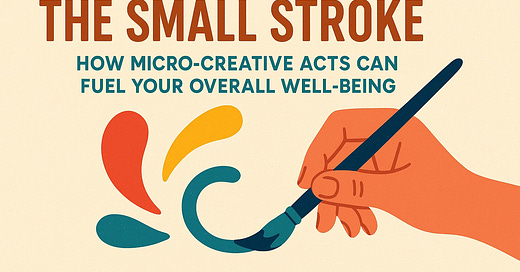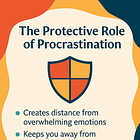The Power of the Small Stroke: How Micro-Creative Acts Can Fuel Your Overall Well-being
Instead of demanding a huge surge of energy for a major project, micro-creative acts (a quick sketch, a few lines of poetry, a spontaneous melody) offer gentle, consistent stimulation.
We live in a world that often measures creative worth by grand gestures, monumental projects, and constant output. The pressure to be an "always on creator" is immense. Yet, for many of us, this relentless pursuit of large-scale productivity can lead to creative depletion, burnout, shame, and even creative paralysis. What if true creative wellness isn't about the magnum opus, but about the consistent, gentle accumulation of small, seemingly insignificant creative acts? What if the "small stroke" holds the key to a more sustainable and joyful creative life?
The Neuroscience of Micro-Dosing Creativity
Our brains are wired for connection and reward. When we engage in creative acts, we activate various neural networks, including the default mode network, which is crucial for generating creative insights. However, chronic exhaustion and stress hormones can literally inhibit the brain regions responsible for creative thinking. This is where the power of the small stroke comes in.
Instead of demanding a huge surge of energy for a major project, micro-creative acts (a quick sketch, a few lines of poetry, a spontaneous melody) offer gentle, consistent stimulation. These small engagements can help to:
Regulate the Nervous System: When our nervous system is overwhelmed, space can feel hostile. Engaging in brief, non-pressured creative moments can act as a "relief valve", helping to downregulate the sympathetic nervous system and promote a sense of calm and safety. This is akin to the concept of polyvagal theory, where small, positive engagements signal safety to the vagus nerve, fostering a more regulated internal state. Your body already knows balance; when it feels out of sync, a small creative act can be a way to re-establish that internal equilibrium.
Combat Executive Dysfunction: Challenges like executive dysfunction can make starting large projects feel insurmountable. The "small stroke" bypasses this barrier by lowering the activation energy required to begin. It leverages the principle of behavioral activation, where even small, manageable steps can break the cycle of inertia and lead to a sense of accomplishment, stimulating dopamine pathways without overwhelming the system. The mess you see might just be data, indicating where your system is overwhelmed. A small stroke can be a gentle way to address this data.
Reframe "Failure" into "Data": In a world that often frames disorganization and unfinished tasks as dysfunction , the small stroke embraces imperfection. If you're grappling with "never-good-enough" feelings , a quick, non-committal creative act can dismantle the pressure of perfectionism. The outcome isn't about a finished product, but about the act itself, reframing what might be perceived as a "mistake" into valuable data about your current state or a new direction. This aligns with a growth mindset, where challenges and perceived setbacks are seen as opportunities for learning and adaptation. Mess, in this context, can be seen as communication, revealing where deeper needs exist.
Foster Emotional Integration: Emotional suppression blocks access to the full range of human experience that feeds our art. Pushing through difficult feelings instead of processing them is part of the depletion cycle. Small creative acts provide a container for these emotions, allowing them to be "expressed without expectation". A rapid, intuitive doodle or a short, abstract piece can offer an "unspoken language" for what your thoughts and emotions are trying to communicate, providing an outlet without the burden of crafting a coherent narrative. This aligns with affect regulation theory, where creative expression serves as a means to process and integrate difficult emotions. Feelings can be used as creative material rather than obstacles to overcome.
Counter the Comparison Trap: When we measure our creative worth by the quantity of finished pieces or compare ourselves to others' perceived output, we fall into a destructive pattern. The "small stroke" encourages tracking how your creative practice affects your well-being instead of just focusing on external metrics. This shift promotes self-worth over comparison.

The Protective Role of the Small Stroke
Often, what appears as "procrastination" is actually a protective mechanism. Procrastination isn't passive; it's adaptive. It creates distance from overwhelming emotions, keeps us away from potential judgment, helps us avoid failure or a sense of inadequacy, and prevents feelings of vulnerability. The small stroke, by its very nature, disarms these protective barriers. It's less intimidating, less prone to judgment, and less likely to trigger a sense of inadequacy because the stakes are inherently lower. It allows for engagement without the perceived threat of failure or the exposure of intense vulnerability that a large, high-stakes project might entail. By offering a gentle point of entry, the small stroke helps reframe the inner critic, allowing us to move forward without feeling that "there's nothing wrong with you".
Integrating the Small Stroke into Your Life
Adopting a "small stroke" philosophy doesn't mean abandoning larger projects. Instead, it creates a robust foundation for sustainable creativity. It's about recognizing your natural rhythms and working with them, not against them.
Consider these gentle shifts to incorporate micro-creative acts into your daily life:
Energy Mapping & Micro-Windows: Notice when you have small pockets of energy or brief moments of inspiration. Instead of waiting for a large, uninterrupted block of time, utilize these micro-windows.
Process Over Output: Shift your mindset from measuring creative worth by the quantity of finished pieces to valuing the journey of creation itself. Celebrate process victories, no matter how small. Ask yourself: does this energize or deplete me? Does it feel aligned or forced? Am I creating from inspiration or obligation?
Emotional Check-ins as Prompts: Before engaging, ask yourself: "How am I feeling, and how might this inform my work?". Use your current emotional state as creative material.
Listen to Your Body's Signals: Fatigue, restlessness, or overwhelm are forms of "creative intelligence". A small, restorative creative act can be the answer to what your body is asking for. Your body isn't lying; if a space feels dysregulating, or you're pushing through physical discomfort, it impacts your creative capacity.
Boundary Setting: Create limits that protect your creative energy. This might mean knowing when to push and when to rest.
Recovery Rituals: Build restoration into your creative routine. This prioritizes diverse forms of rest and can include embracing slower work and degrowth principles in your creative practice.
In a world that demands endless productivity, choosing creative wellness through the power of the small stroke is a revolutionary act. It's a declaration that your humanity matters more than your output , and that your long-term creative capacity is more valuable than short-term gains. Your creativity doesn't need to be constant to be real, or productive to be valuable. It simply needs you - rested, aware, emotionally integrated, and creatively alive. When we create from a place of wellness rather than depletion, something magical happens: our work becomes more authentic, sustainable, and meaningful.
If you are interested in exploring how creative wellness can transform your practice, consider diving deeper with resources like the 'Creative Mental Health Foundation Worksheet' and 'Creative Mental Health Foundation Journal', which are a few of the tools I offer in the Create Me Free shop.
Would you rather work together 1:1 over Zoom? I’d love to connect! Learn more.
You Might Also Like to Read:










I find everything you write so accessible and helpful. Much appreciated!